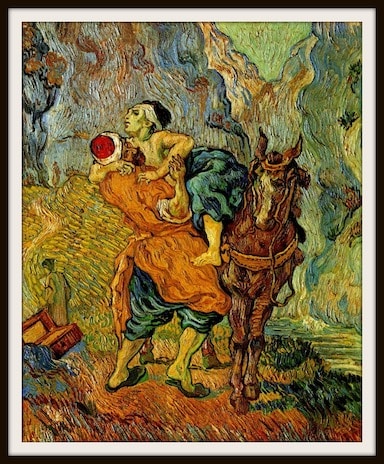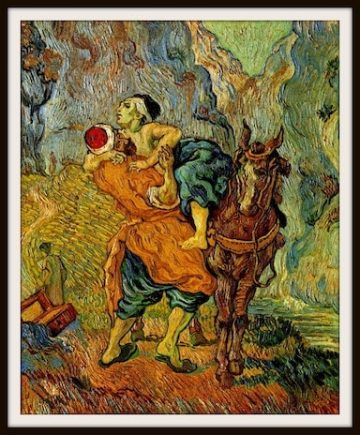Image – The Good Samaritan, by Vincent Van Gogh
Van Gogh is one of the artists whose paintings have moved me to tears. Not his most well known paintings, though. I have been able to see some special exhibits that have gathered his paintings from collections all over the world. There I have stood, transfixed, in front of paintings that are rarely seen in prints or outside of these special exhibits. When I spent a few weeks in Amsterdam almost 30 years ago, I visited the Van Gogh museum often. Learning about his life, his passion, his seeking, his yearning for acceptance, peace, healing, his drive to create, and seeing how his work developed and reflected so much of this. It was a powerful experience to walk through the museum and feel as though I was observing his extraordinary and complex life.
The Van Gogh painting that continues to move me the most is The Good Samaritan.
A few months ago, Mike and I were able to spend some time in France. We spent a day in St. Remy so we could visit the hospital where Van Gogh had voluntarily committed himself. St. Paul Asylum is in a beautiful setting, still surrounded by views of fields and natural landscape. As we walked up the lane toward the complex, I stopped at plaques that depicted the paintings Van Gogh had painted while standing in that spot, many of them landscapes showing a view similar to what we saw that day.
Just inside the main gate, I was surprised to see a marker depicting his painting of The Good Samaritan. It said he had worked on the painting here. I felt I was on sacred ground.
I looked at the print of this powerful parable. This is the story that has come to me, confronted me when I want to judge or condemn, when I want to excuse my failure to love or extend grace, when I want to deny the ways salvation shows up for me from people I haven’t been willing to see.
The parable lesson that keeps coming to me is this – If there is anyone I don’t love, I don’t love anyone.
I looked at the image, and I saw all the familiar characters and elements. There was the road, the place of journeying that, no matter how familiar, could become dangerous and deadly at any moment. There was the injured traveler that many fail to identify with, even though Christ suggested he was a part of the orthodox church which had judged the Samaritans to be unclean. There were the ones of high station and calling who had passed by one in need, and hurried on their way. There was the box, once full of the traveler’s riches, now broken open and empty. There was the Samaritan, lifting the injured traveler up onto his own animal, doing all he could to save his life and heal him.
I have seen so many depictions of this story. Why is this one especially powerful to me?
Unlike most, this one does not show the characters in calm poses wearing sanitized clothing, with the Samaritan easily cradling a wounded, but peaceful traveler who is gratefully accepting help. In Van Gogh’s painting, the vivid colors and strokes depict a setting that juxtaposes a smooth path winding through rough rocks, next to craggy cliffs and turbulent waters. Every brushstroke seems to contain a possibility of peace, or chaos. The supposedly elite people are barely noticeable in the background.
But the most striking part is the interaction between the Samaritan and traveler. It is awkward, almost clumsy. It almost looks like there is a wrestle going on. The Samaritan is trying to lift the wounded traveler onto his patient animal. Is the traveler struggling, or resisting, or just not able to physically cooperate with his helper? Is he gratefully accepting help while struggling to physically aid in his own salvation? Or is there another kind of turmoil for him? Is he struggling because the rescuer is different from what he expected? This rescuer is not someone he has seen as worthy. Is this more than a physical challenge for the Samaritan? Is he also confronted by the thought of helping someone who has excluded him and his people? Or is his commitment to the God of love the only law for him, and there is no hesitation to provide wherever there is need? Is he truly and completely a savior, no matter how challenging the task to lift this wounded person up?
I can’t help but focus on their faces. The two faces are so close, and at any moment had been or would be completely face to face. In the moment of the painting, the Samaritan’s face seems ruddy with life and exertion, focusing on the task at hand. The traveler’s face is pale, and looking away, almost as if he is struggling to directly face the one who brings him life. Each place where the traveler is in contact with the Samaritan, healthy color seems to spread, overcoming the deathly pale.
Is this what it is like to offer and receive help, healing, salvation? I think I, like many, want to imagine an idealized scene where I, the wounded traveler who has been the victim of attacks from adversaries, gratefully accept the offering of healing from the kind, handsome, just-as-I-pictured-him, acceptable savior.
What if help comes in ways I hadn’t considered, from people I could never imagine could heal me? What if I have resisted those who are trying to lift me? What if I struggle to look into the eyes of those whose only law is the law of love? What if I am clumsy, not knowing what to do when healing is offered, and it looks different from what I expected? What if this is not about being surrounded by clarity and light and rising effortlessly to walk with God among the clouds in some distant unknowable future time?
What if salvation is awkward?
The most personal, salvific, healing moments I have had with God have been during times of dark despair. It has been in the messiest moments of deep woundedness when I have finally been open to the intimate awareness and presence of Them. In those moments, there has been no magic removal of pain, no fixing of a problem. There has been such a deep presence, I feel as though I am seen, face to face. The message “I am with you, always” is so loving, there is no room for any thought of unworthiness, or any possibility of being beyond grace. I fumble to understand, to explain, to ask clumsy questions. And They are there through it all. Sitting in the deep, messy wounds with me. Not at some future time in a future life when everything is worked out. Salvation. Heaven is here, eternal life is now.
Christ spoke in the present tense. The kingdom is within you. You are blessed.
This is the road you journey. All things are possible. What you treasure is lost. Those you revere pass by. The one you don’t expect, brings healing, new understanding, deeper love. This is clumsy, and unfamiliar. I am with you. This is awkward. This brings new life. You are afraid. I am with you. It is okay if you look away. I am here while you wrestle. When you are ready. Face to face.
There is nothing more godlike for us to do than to help each other along, however awkward, on our journey home.





3 Responses
I was struck by where the mass of the individuals was placed in the picture.
The Good Samaritan is transferring weight between the balls of his feet and pushing some personal mass forward to create a fulcrum to balance the traveler onto the donkey.
The traveler is perched (for lack of a better term) between the effects of gravity, the Good Samaritan, and the donkey.
The donkey wants to shy away from the unexpected mass of the traveler. You can almost see the wiggling sidestep to bypass receiving the traveler on it’s back.
This is beautiful! Thanks for sharing
It’s true about being loved and to be unloved. Van Gogh is my favorite artist. The Laws of Love where the barriers are broken. You can love from a distance also with prayer.